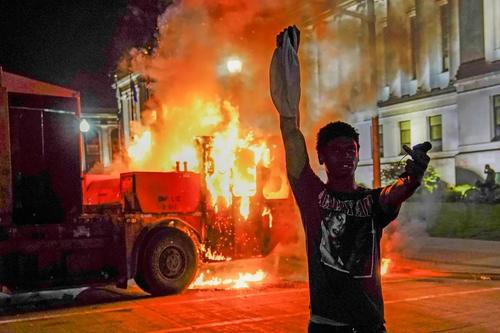The New York Times Held Back Story On Kenosha Riot Damage Until After 2020 Election
Source: Zero Hedge
Former New York Times contributor Nellie Bowles’ has relayed a disturbing account of an incident at America’s ‘paper of record’ concerning coverage of the riots in Kenosha, Wisconsin following the August 2020 police shooting of Jacob Blake – where during just one evening of ‘protests,’ the Kenosha Fire Department responded to 37 fires, multiple shootings, assaults, and other acts of vandalism.

In her “TGIF” newsletter (which can be read at Bari Weiss’ substack here), Bowles explains how she traveled to Kenosha to cover the riots – and in particular to see whether the prevailing Democratic narrative that the destruction was “both good and healthy” for promoting racial justice was true (it wasn’t).
After writing a sobering take on how the riots devastated small businesses – many owned by minorities who would have little chance of recovering, the Times refused to publish it until after the 2020 US election. In fact, they ran it less than a week later.
Perhaps her coverage was a bit too… damning?
On the burned-out blocks hit by unrest since the killing George Floyd, an unarmed Black man, in Minneapolis in late spring, the reality is complicated. Mr. Floyd’s death was the start of months of protests for racial justice led by the Black Lives Matter movement that have left long-term economic damage, especially in lower-income business districts.
While large chains like Walmart and Best Buy have excellent insurance, many small businesses that have been burned down in the riots lack similar coverage. And for them, there is no easy way to replace all that they lost.
…
In Kenosha, more than 35 small businesses were destroyed, and around 80 were damaged, according to the city’s business association. Almost all are locally owned and many are underinsured or struggling to manage. –NYT
Bowles went deep – interviewing several affected small business owners who conveyed their “broadly felt” pain as a result of the riots – with much of the damage being committed by “white protesters destroying property in the name of Black Lives,” according to a local shop owner. “It’s some blue-haired, latte-drinking hippie in Seattle coming here to raise hell while they go home to their nice beds,” said the victim, adding “They don’t care about any of us.”
Not a good look for the racial justice movement, or Democrats in general who might be forced to address an uncomfortable truth on their side of the aisle right before an election.
The Times gave Bowles the runaround as to why they didn’t run the piece when she filed it – which we can only assume was meant to help Biden win. Read below for her first-hand account.
Authored by Nellie Bowles via Common Sense with Bari Weiss (emphasis ours),
A note on Kenosha in light of the Kyle Rittenhouse trial: Until quite recently, the mainstream liberal argument was that burning down businesses for racial justice was both good and healthy. Burnings allowed for the expression of righteous rage, and the businesses all had insurance to rebuild.
When I was at the New York Times, I went to Kenosha to see about this, and it turned out to be not true. The part of Kenosha that people burned in the riots was the poor, multi-racial commercial district, full of small, underinsured cell phone shops and car lots. It was very sad to see and to hear from people who had suffered. Beyond the financial loss, small storefronts are quite meaningful to their owners and communities, which continuously baffles the Zoom-class.
Something odd happened with that story after I filed it. It didn’t run. It sat and sat.
Now it could be that the piece was just bad. I’ve sent in bad ones before, and I’ll do it again. A few weeks after I filed, an editor told me: The Times wouldn’t be able to run my Kenosha insurance debacle piece until after the 2020 election, so sorry.
There were a variety of reasons given—space, timing, tweaks here or there.
Eventually the election passed. Biden was in the White House. And my Kenosha story ran. Whatever the reason for holding the piece, covering the suffering after the riots was not a priority. The reality that brought Kyle Rittenhouse into the streets was one we reporters were meant to ignore. The old man who tried to put out a blaze at a Kenosha store had his jaw broken. The top editor of the Philadelphia Inquirer had to resign in June 2020 amid staff outcry for publishing a piece with the headline, “Buildings Matter, Too.”
If you lived in those neighborhoods on fire, you were not supposed to get an extinguisher. The proper response — the only acceptable response — was to see the brick and mortar torn down, to watch the fires burn and to say: thank you.



